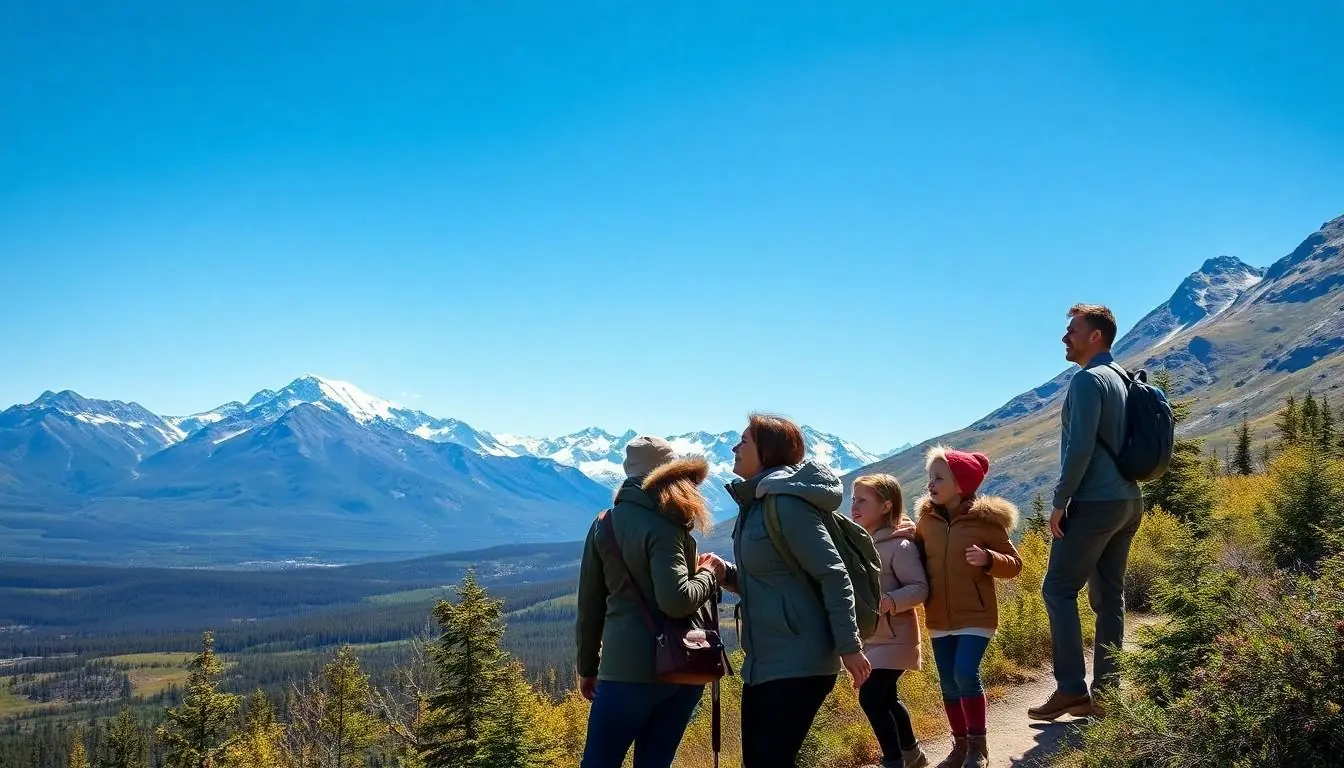Planning a family adventure to Alaska doesn’t have to break the bank. The Last Frontier offers breathtaking wilderness experiences, stunning glaciers and abundant wildlife viewing opportunities that won’t empty your wallet. From camping under the midnight sun to spotting whales from public beaches, budget-conscious families can experience Alaska’s magic without the premium price tag.
Smart travelers know that timing is everything when visiting Alaska. By choosing shoulder season dates, booking accommodations in advance and taking advantage of free national park days, families can slash their vacation costs significantly. With a bit of strategic planning and insider knowledge, it’s possible to create unforgettable memories while keeping expenses manageable in this bucket-list destination.
Table of Contents
ToggleWhy Alaska Is Perfect for Family Adventures
Alaska’s wilderness offers an unmatched backdrop for family exploration with 17 national parks featuring glaciers, mountains, forests. Families connect through shared experiences like spotting grizzly bears in Denali National Park or watching humpback whales breach in Kenai Fjords.
The Last Frontier provides educational opportunities embedded in natural settings. Children learn about:
- Native Alaskan cultures through interactive museum exhibits
- Glacier formation by walking on ancient ice fields
- Marine ecosystems while kayaking pristine waters
- Wildlife behavior during guided nature walks
Accessibility makes Alaska ideal for multigenerational travel with:
- Paved trails at Exit Glacier for stroller access
- Wheelchair-friendly viewing platforms at Brooks Falls
- Short hiking options for small children
- Multiple rest areas along scenic drives
Alaska’s summer daylight extends outdoor adventure time with:
| Month | Hours of Daylight |
|---|---|
| June | 18-22 hours |
| July | 16-20 hours |
| August | 14-18 hours |
The state caters to varied interests through:
- Gold panning activities in historic mining towns
- Fishing excursions in crystal-clear streams
- Berry picking in vast meadows
- Junior Ranger programs at national parks
- Camping under the midnight sun
- Spotting moose from scenic train rides
- Learning photography at wildlife viewpoints
- Making s’mores near glacier viewpoints
Best Time to Visit Alaska on a Budget
Alaska’s peak tourist season runs from June through August, with premium prices for flights, accommodations, and activities. Budget-conscious families maximize their savings by planning trips during specific times of the year.
Shoulder Season Benefits
The shoulder seasons of May and September offer significant cost savings on Alaska family vacations. Hotel rates drop 10-25% compared to peak summer prices. Airlines feature reduced fares with savings up to 40% on round-trip flights. Tourist attractions operate with smaller crowds, creating more intimate experiences at places like Denali National Park. Many tour operators provide shoulder season discounts ranging from 15-30% off standard rates. Families enjoy enhanced wildlife viewing opportunities as animals prepare for summer breeding or winter hibernation during these transitional months.
Weather Considerations
May temperatures range from 45-65°F with occasional rain showers. September brings cooler conditions between 35-55°F with increased precipitation possibilities. Daylight hours vary significantly:
| Month | Daylight Hours | Average Temperature (°F) | Precipitation (inches) |
|---|---|---|---|
| May | 16-18 | 45-65 | 0.8 |
| Sept | 12-14 | 35-55 | 2.4 |
Morning frost appears in September, creating stunning photo opportunities. Weather patterns remain stable enough for most outdoor activities while requiring proper layered clothing. Northern lights viewing becomes possible in September as darkness returns to the evening sky.
Budget-Friendly Accommodation Options
Alaska offers diverse lodging choices that accommodate various budgets without compromising comfort or experience. Strategic selection of accommodation types saves families up to 60% on lodging costs during their Alaskan adventure.
Camping and RV Parks
Alaska’s public campgrounds provide economical overnight stays starting at $15 per night in state parks. The Denali National Park features 6 established campgrounds with basic amenities including fire rings, picnic tables, and bear-proof food lockers. Riley Creek Campground charges $30 per night offering flush toilets, potable water, and a general store. RV parks throughout Alaska’s major routes provide full hookups ranging from $35-$65 nightly. Popular options include:
- Centennial Campground in Anchorage: $20/night with coin-operated showers
- Chena River State Recreation Area: $15/night featuring riverside spots
- Seward Waterfront Park: $40/night including electric hookups
- Tok RV Village: $45/night offering laundry facilities
Affordable Hotels and Hostels
Budget hotels in Alaska’s popular destinations range from $89-$150 per night during shoulder seasons. Hostels present the most economical option at $30-$50 per bed. The Anchorage Downtown Hostel provides family rooms at $125 nightly including kitchen access. Notable budget accommodations include:
- Pioneer Inn Fairbanks: $95/night with continental breakfast
- Alaska Backpackers Inn: $40/person including WiFi access
- Kenai Peninsula Motel: $115/night featuring kitchenettes
- Base Camp Anchorage: $135/night for family suites
Booking platforms like Hotels.com offer 15-25% discounts on advance reservations made 3 months prior. Many properties provide additional savings through AAA memberships or extended-stay rates.
Cost-Saving Transportation Tips
Strategic transportation planning reduces travel expenses in Alaska by up to 40%. Several cost-effective options exist for both reaching Alaska and exploring its vast wilderness.
Getting to Alaska
Flying into Anchorage International Airport offers the most economical entry point, with airlines like Alaska Airlines offering companion fares starting at $99. Budget carriers connect Seattle to Anchorage with fares from $200 round-trip during shoulder seasons. Securing flights 3-4 months in advance yields savings of 15-30%. Travel rewards credit cards provide airline miles redemption opportunities, cutting flight costs by up to 50%. Cruise packages from Seattle or Vancouver start at $599 per person in May or September, including transportation and accommodation.
Getting Around Alaska
The Alaska Railroad’s Adventure Card saves families 20% on train travel between major destinations. Public buses connect cities for $50-75 per route, while shuttle services to national parks cost $30-45 per person. Car rentals average $65 daily in shoulder seasons, with weekly rates offering 25% savings. Local transit systems in Anchorage, Fairbanks, and Juneau charge $2 per ride with free transfers. Combining transportation methods maximizes savings – examples include using the train for scenic routes and buses for city exploration. Tour companies offer multi-destination packages with group discounts of 10-15% for families of four or more.
Free and Low-Cost Activities
Alaska offers numerous cost-free outdoor activities for families to experience its pristine wilderness. Strategic planning unlocks countless opportunities to explore without spending money.
National Parks and Hiking
The National Park Service provides free entry to Alaska’s national parks on designated days throughout the year. Denali National Park features 87 miles of maintained trails ranging from easy walks to challenging hikes, accommodating all skill levels. Exit Glacier in Kenai Fjords National Park offers accessible viewing areas with interpretive signs explaining glacier formation. The Tony Knowles Coastal Trail in Anchorage extends 11 miles along the coast, providing free access to scenic views of Cook Inlet. Children earn free Junior Ranger badges by completing educational activities at visitor centers. Chugach State Park maintains 280 miles of trails with no entrance fees, including the popular Flattop Mountain trail with panoramic city views.
Wildlife Viewing Spots
Potter Marsh Bird Sanctuary features a 1,550-foot wooden boardwalk for spotting waterfowl, eagles moose. The Ship Creek Viewing Platform in downtown Anchorage lets families watch salmon runs from July through September. Eagles gather at Homer Spit from April through October, creating opportunities for free bird watching. The Alaska Wildlife Conservation Center charges $17 for adults with children under 5 entering free, offering guaranteed views of bears, moose elk. Visitors spot whales from shore at Beluga Point along Turnagain Arm during summer months. The Tony Knowles Coastal Trail includes multiple designated wildlife viewing stations equipped with interpretive signs identification guides.
Money-Saving Food Strategies
Food costs consume a significant portion of any Alaska vacation budget, with restaurant meals averaging $25-35 per person. Strategic meal planning reduces daily food expenses by 40-60% for families exploring the Last Frontier.
Grocery Shopping Tips
Alaska’s major grocery chains include Fred Meyer, Safeway Carrs offering competitive prices in urban areas. Stock up on essentials in Anchorage, where groceries cost 15-20% less than in remote locations. Local stores like Three Bears Alaska feature weekly sales on fresh produce, meats, and pantry items. Joining store loyalty programs saves an additional 5-10% on purchases. Smart shopping strategies include:
- Buying bulk snacks, trail mix, and dried goods
- Selecting seasonal Alaskan produce like berries, mushrooms, and root vegetables
- Packing reusable water bottles to fill at natural springs
- Shopping at farmers markets in Anchorage, Fairbanks, and Juneau for fresh local produce
- Using coolers to store perishables during road trips
Affordable Dining Options
Local eateries provide authentic Alaskan cuisine at reasonable prices. Food trucks in downtown Anchorage serve halibut tacos, reindeer sausages, and salmon burgers for $8-15 per meal. Popular budget-friendly spots include:
| Restaurant Type | Average Cost | Location Examples |
|---|---|---|
| Food Trucks | $8-15 | Anchorage, Fairbanks |
| Casual Diners | $12-20 | Lucky Wishbone, Arctic Roadrunner |
| Seafood Shacks | $15-25 | Seward, Homer |
| Brewpubs | $15-30 | Moose’s Tooth, Bear Tooth |
Local lunch specials offer 20-30% savings on regular menu prices. Many hotels include complimentary breakfast, reducing daily food expenses by $10-15 per person.
Conclusion
Alaska’s majestic wilderness doesn’t have to drain a family’s savings account. Smart planning and strategic choices can transform this bucket-list destination into an achievable dream vacation. From shoulder season travel and budget-friendly accommodations to free national park activities and cost-effective meal planning families can experience Alaska’s wonders without breaking the bank.
The key lies in early planning careful timing and making the most of available resources. By following these budget-conscious strategies families can create lasting memories while exploring glaciers watching wildlife and immersing themselves in Alaska’s rich cultural heritage. The Last Frontier awaits – and it’s more accessible than many might think.




